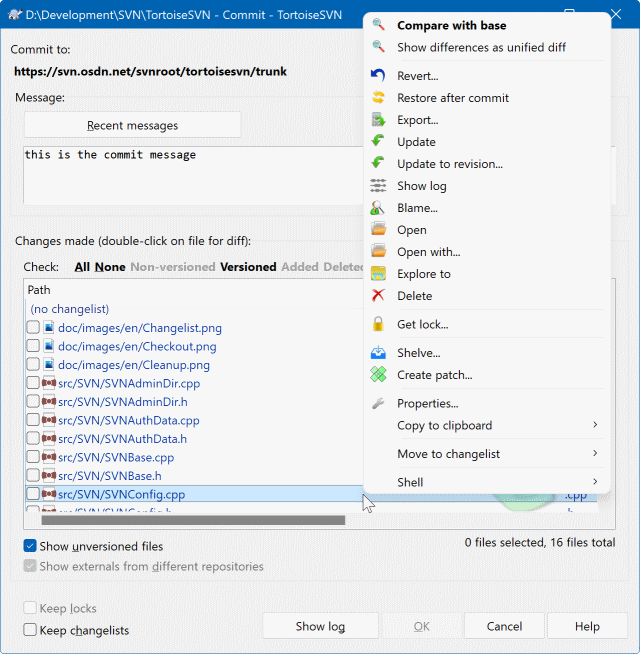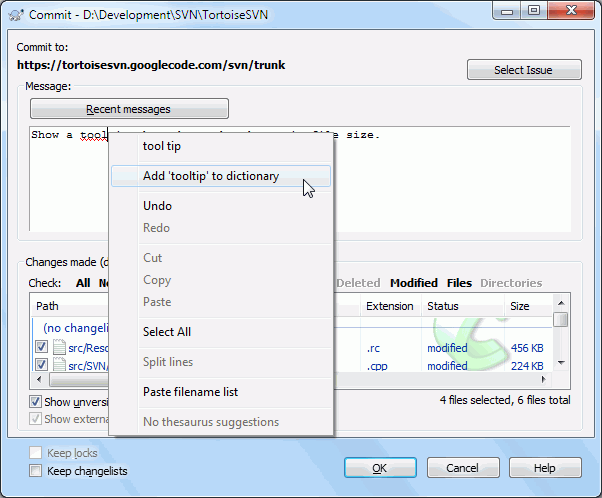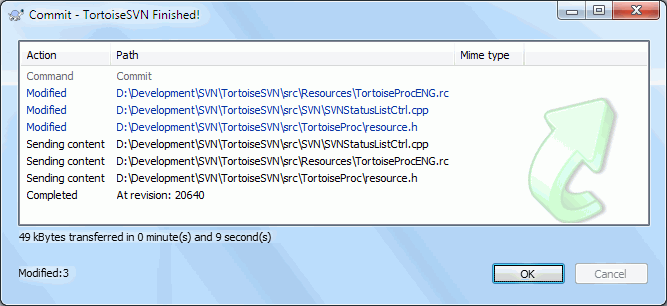Sending the changes you made to your working copy is known as committing the changes. But before you commit you have to make sure that your working copy is up to date. You can either use → directly. Or you can use → first, to see which files have changed locally or on the server.
If your working copy is up to date and there are no conflicts, you are ready to commit your changes. Select any file and/or folders you want to commit, then → .
The commit dialog will show you every changed file, including added, deleted and unversioned files. If you don't want a changed file to be committed, just uncheck that file. If you want to include an unversioned file, just check that file to add it to the commit.
To quickly check or uncheck types of files like all versioned files or all modified files, click the link items just above the list of shown items.
For information on the coloring and overlays of the items according to their status, please see the section called “Local and Remote Status”.
Items which have been switched to a different repository path are
also indicated using an (s) marker. You may have
switched something while working on a branch and forgotten to switch
back to trunk. This is your warning sign!
Commit files or folders?
When you commit files, the commit dialog shows only the files you have selected. When you commit a folder the commit dialog will select the changed files automatically. If you forget about a new file you created, committing the folder will find it anyway. Committing a folder does not mean that every file gets marked as changed; It just makes your life easier by doing more work for you.
Many unversioned files in the commit dialog
If you think that the commit dialog shows you too many unversioned (e.g. compiler generated or editor backup) files, there are several ways to handle this. You can:
add the file (or a wildcard extension) to the list of files to exclude on the settings page. This will affect every working copy you have.
add the file to the
svn:ignorelist using → This will only affect the directory on which you set thesvn:ignoreproperty. Using the SVN Property Dialog, you can alter thesvn:ignoreproperty for a directory.add the file to the
svn:global-ignoreslist using → This will affect the directory on which you set thesvn:global-ignoresproperty and all subfolders as well.
Read the section called “Ignoring Files And Directories” for more information.
Double clicking on any modified file in the commit dialog will launch the external diff tool to show your changes. The context menu will give you more options, as shown in the screenshot. You can also drag files from here into another application such as a text editor or an IDE.
You can select or deselect items by clicking on the checkbox to the left of the item. For directories you can use Shift-select to make the action recursive.
The columns displayed in the bottom pane are customizable. If you right click on any column header you will see a context menu allowing you to select which columns are displayed. You can also change column width by using the drag handle which appears when you move the mouse over a column boundary. These customizations are preserved, so you will see the same headings next time.
By default when you commit changes, any locks that you hold on files
are released automatically after the commit succeeds. If you want
to keep those locks, make sure the Keep locks
checkbox is checked. The default state of this checkbox is taken
from the no_unlock option in the Subversion
configuration file. Read the section called “General Settings”
for information on how to edit the Subversion configuration file.
Warning when committing to a tag
Usually, commits are done to the trunk or a branch, but not to tags. After all, a tag is considered fixed and should not change.
If a commit is attempted to a tag URL, TortoiseSVN shows a confirmation dialog first to ensure whether this is really what is intended. Because most of the time such a commit is done by accident.
However, this check only works if the repository layout is one of the
recommended ones, meaning it uses the names trunk,
branches and tags to mark
the three main areas. In case the setup is different, the detection
of what is a tag/branch/trunk (also known as
classification patterns), can be configured in the
settings dialog:
the section called “Revision Graph Settings”
Drag and Drop
You can drag files into the commit dialog from elsewhere, so long as the working copies are checked out from the same repository. For example, you may have a huge working copy with several explorer windows open to look at distant folders of the hierarchy. If you want to avoid committing from the top level folder (with a lengthy folder crawl to check for changes) you can open the commit dialog for one folder and drag in items from the other windows to include within the same atomic commit.
You can drag unversioned files which reside within a working copy into the commit dialog, and they will be SVN added automatically.
Dragging files from the list at the bottom of the commit dialog to the log message edit box will insert the paths as plain text into that edit box. This is useful if you want to write commit log messages that include the paths that are affected by the commit.
Repairing External Renames
Sometimes files get renamed outside of Subversion, and they show up in the file list as a missing file and an unversioned file. To avoid losing the history you need to notify Subversion about the connection. Simply select both the old name (missing) and the new name (unversioned) and use → to pair the two files as a rename.
Repairing External Copies
If you made a copy of a file but forgot to use the Subversion command to do so, you can repair that copy so the new file doesn't lose its history. Simply select both the old name (normal or modified) and the new name (unversioned) and use → to pair the two files as a copy.
The commit dialog supports Subversion's changelist feature to help with grouping related files together. Find out about this feature in the section called “Change Lists”.
Sometimes you want to only commit parts of the changes you made to a file. Such a situation usually happens when you're working on something but then an urgent fix needs to be committed, and that fix happens to be in the same file you're working on.
right click on the file and use → . This will create a copy of the file as it is. Then you can edit the file, e.g. in a text editor and undo all the changes you don't want to commit. After saving those changes you can commit the file.
Using TortoiseMerge
If you use TortoiseMerge to edit the file, you can either edit the changes as you're used to, or mark all the changes that you want to include. right click on a modified block and use → to include that change. Finally right click and use → which will change the right view to only include the changes you've marked before and undo the changes you have not marked.
After the commit is done, the copy of the file is restored automatically, and you have the file with all your modifications that were not committed back.
Sometimes you have versioned files that change frequently but that you really don't want to commit. Sometimes this indicates a flaw in your build process - why are those files versioned? should you be using template files? But occasionally it is inevitable. A classic reason is that your IDE changes a timestamp in the project file every time you build. The project file has to be versioned as it includes all the build settings, but it doesn't need to be committed just because the timestamp changed.
To help out in awkward cases like this, we have reserved a changelist
called ignore-on-commit. Any file added to this
changelist will automatically be unchecked in the commit dialog.
You can still commit changes, but you have to select it manually
in the commit dialog.
Be sure to enter a log message which describes the changes you are committing. This will help you to see what happened and when, as you browse through the project log messages at a later date. The message can be as long or as brief as you like; many projects have guidelines for what should be included, the language to use, and sometimes even a strict format.
You can apply simple formatting to your log messages using a convention
similar to that used within emails.
To apply styling to text, use
*text* for bold,
_text_ for underlining, and
^text^ for italics.
TortoiseSVN includes a spellchecker to help you get your log messages
right. This will highlight any mis-spelled words. Use the context menu
to access the suggested corrections. Of course, it doesn't know
every technical term that you do, so correctly
spelt words will sometimes show up as errors. But don't worry. You can
just add them to your personal dictionary using the context menu.
The log message window also includes a filename and function auto-completion
facility. This uses regular expressions to extract class and function names
from the (text) files you are committing, as well as the filenames themselves.
If a word you are typing matches anything in the list (after you have typed at
least 3 characters, or pressed Ctrl+Space),
a drop-down appears allowing you to select the full name.
The regular expressions supplied with TortoiseSVN are held in the TortoiseSVN
installation bin folder. You can also define your own
regexes and store them in %APPDATA%\TortoiseSVN\autolist.txt.
Of course your private autolist will not be overwritten when you update your
installation of TortoiseSVN. If you are unfamiliar with regular expressions,
take a look at the introduction at
https://en.wikipedia.org/wiki/Regular_expression
,
and the online documentation and tutorial at
https://www.regular-expressions.info/
.
Getting the regex just right can be tricky, so to help you sort out a
suitable expression there is a test dialog which allows you to enter
an expression and then type in filenames to test it against.
Start it from the command prompt using the command
TortoiseProc.exe /command:autotexttest.
The log message window also includes a commit message snippet facility.
These snippets are shown in the autocomplete dropdown once you type
a snippet shortcut, and selecting the snippet in the autocomplete dropdown
then inserts the full text of the snippet.
The snippets supplied with TortoiseSVN are held in the TortoiseSVN
installation bin folder. You can also define your own
snippets and store them in %APPDATA%\TortoiseSVN\snippet.txt.
# is the comment character. Newlines can be inserted
by escaping them like this: \n and \r.
To insert a backslash, escape it like this: \\.
You can re-use previously entered log messages. Just click on to view a list of the last few messages you entered for this working copy. The number of stored messages can be customized in the TortoiseSVN settings dialog.
You can clear all stored commit messages from the Saved data page of TortoiseSVN's settings, or you can clear individual messages from within the Recent messages dialog using the Delete key.
If you want to include the checked paths in your log message, you can use the command → in the edit control.
Another way to insert the paths into the log message is to simply drag the files from the file list onto the edit control.
Special Folder Properties
There are several special folder properties which can be used to help give more control over the formatting of commit log messages and the language used by the spellchecker module. Read the section called “Project Settings” for further information.
Integration with Bug Tracking Tools
If you have activated the bug tracking system, you can set one or more Issues in the Bug-ID / Issue-Nr: text box. Multiple issues should be comma separated. Alternatively, if you are using regex-based bug tracking support, just add your issue references as part of the log message. Learn more in the section called “Integration with Bug Tracking Systems / Issue Trackers”.
After pressing , a dialog appears displaying the progress of the commit.
The progress dialog uses colour coding to highlight different commit actions
- Blue
Committing a modification.
- Purple
Committing a new addition.
- Dark red
Committing a deletion or a replacement.
- Black
All other items.
This is the default colour scheme, but you can customise those colours using the settings dialog. Read the section called “TortoiseSVN Colour Settings” for more information.


